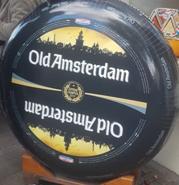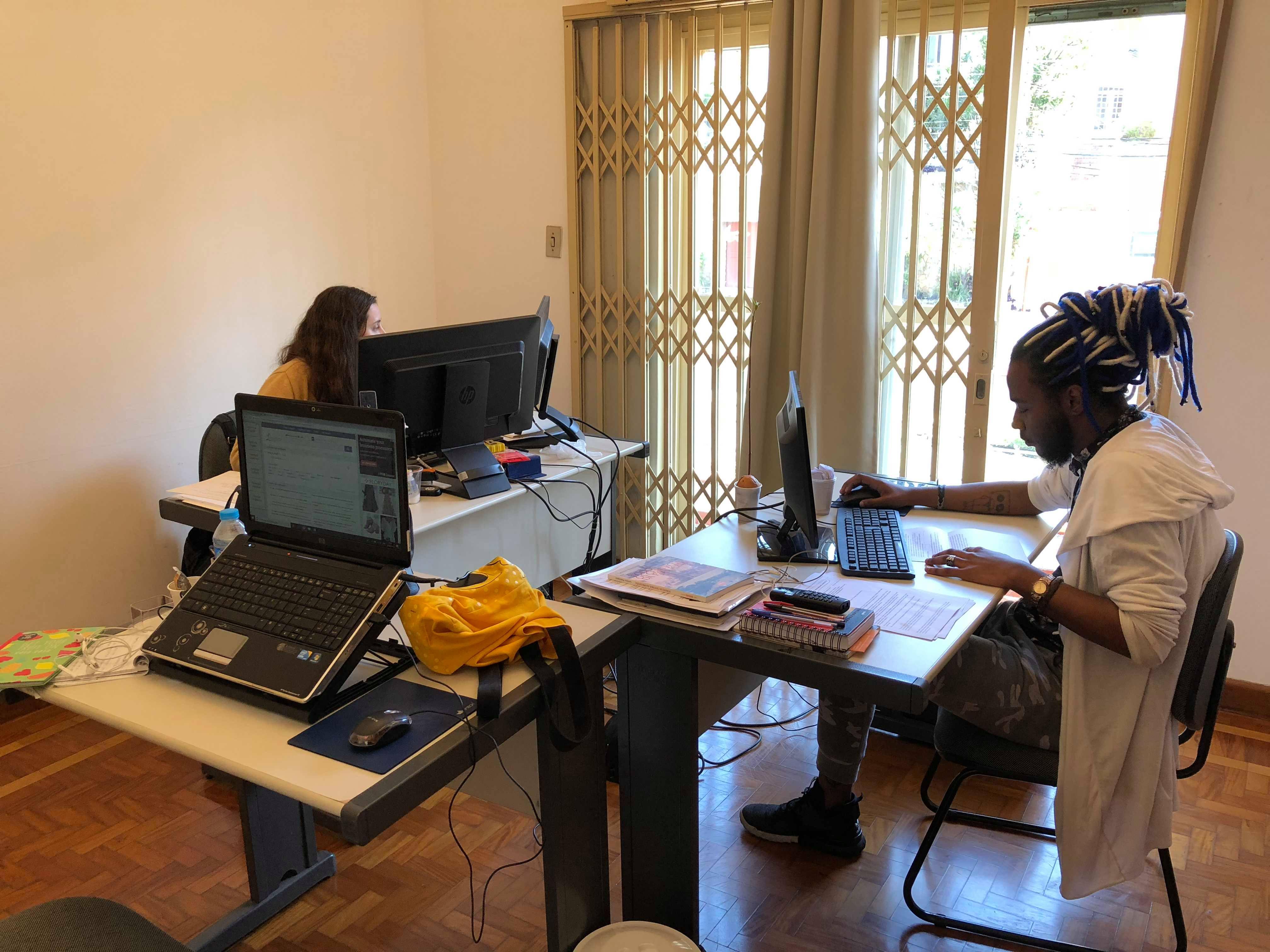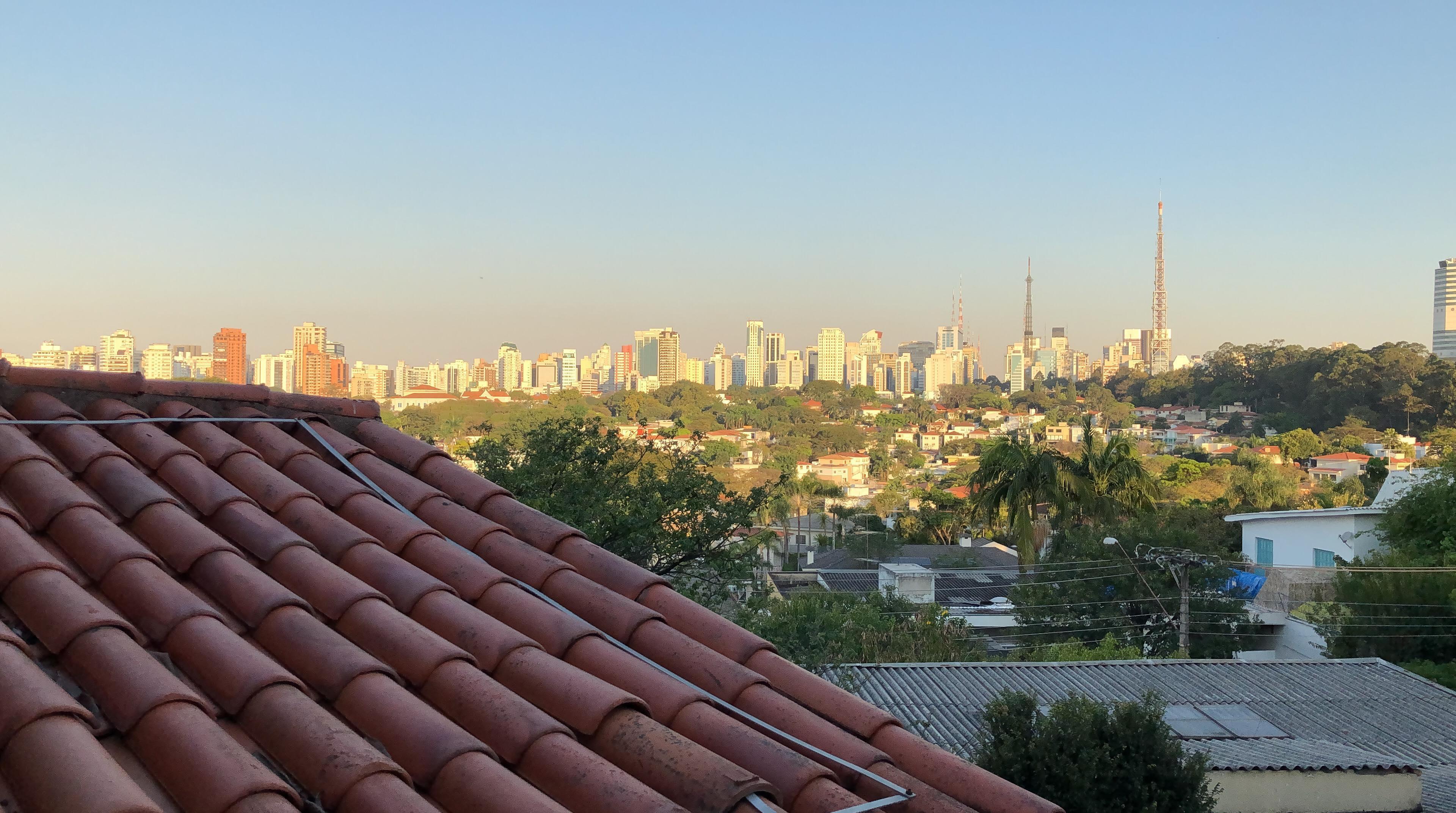Accueillir l'anglais dans la langue française p.13


The culture that isn’t being spoken about p.15 Argentina: Myths and Truths p.7


Issue 31March 2019
La vida en los Altos de la Florida p.10
Chair
Emily Darby
Secretary
Imogen Burgoyne
Treasurer
Charlotte Lau
Social & Publicity
Kirsten Kitchener
Creative Designer
Fiona Milena
Kozlowska
Proof-Readers
Shade
Owomoyela
& Kate Ezard
Current Affairs
Michael Curzon
Travel
Megan Nicholls
Culture
Maria Allon
Food & Drink
Flick Hemming
Life & Style
Alex Jo Brown
French
Holly Hunt
Spanish
Rebekah
Quixano
Henriques
German
Lily King
Italian
Flick Hemming
Catalan
Cecilia Hallpike
Russian
Robert Miller
Chinese
Charlotte Lau
Portuguese
Isabel Baldwin
Dear Readers,
With spring around the corner, and exam season looming, let me thank you for picking up a copy of The Linguist! I hope we can keep you company with some fascinating pieces with a dash of linguistic diversity. But first, some exciting news from us here at Linguist HQ!
We recently elected a brand new Committee and editorial team at our recent AGM, thank you to everyone who came!
The names of your new team will be officially posted very soon on our Facebook page, (The UoB Linguist) so please keep an eye out! I hope you’re as excited as I am about the exciting opportunities next year’s time has instore for us all.
With that said, I should mention the amazing time I have had being Chair over the past year. I can’t believe it’s been a year already! It will be sad to say goodbye, but I am incredibly excited for the future of the magazine. It has been a truly rewarding experience, as well as a learning curve that continues to teach me new things every day.
However, most of all, I always look forward to reading the exceptional pieces our talented editors and writers put together each issue, as well as all the magnificent work the designers and proofreaders provide. It has been an honour to be the Chair of the Linguist 2018-2019, but I wouldn’t have been able to do half of the amazing things I did this year if it hadn’t been for my wonderful team! Now without further ado, let's turn our attention to Issue #31!
This month we are extending our outlook to Africa in the Current Affairs section where we are given a glance into the country’s political situation and the country’s fight against terrorism.
Meanwhile, in an extraordinary feature, Culture writer Emma Rayers lets us in on the ‘Culture that isn’t
theuoblinguist.co.uk
being spoken about’, as we welcome a brilliant piece in association with the UoB Sign Language Society. Rayers tells us about the often overlooked world of deaf culture and the importance of increasing awareness of it and one of the most vital languages of all in our society today, British Sign Language.
Take a trip down the canals of Amsterdam and feast your eyes on some Dutch cuisine in the Food and Drink section on Page 5. Enjoy a wealth of delicacies from waffles to Dutch french fries.
After you’ve finished up there head over to Argentina, where writer Katie Macdonald tells us which myths about the country are true, including whether their diet consists mainly of steak, whether Argentinians really dislike the Brits.
On Page 10 we’re transported to Colombia where we learn about the town of Los Altos de Florida, an area that was built from the ground up by its residents in a genuinely fascinating look into surmounting poverty in Latin America.
Find out about rising star Rosalía in the Catalan section, and what it’s like to work in Brazil over in the Portuguese section.
I wish I could tell you about every one of the fabulous articles we have in this edition, but I will let you check them out for yourselves!
Again, a big thank you to everyone who helped make this edition happen and to you the readers, without you this would not be possible!
I look forward to handing the magazine over to a fantastic new team this summer and I look forward to introducing them to you very soon! Happy reading!
Emily Darby Chair and Editor-in-Chief, The Linguist
Issue 31 - March 2019
The Linguist Team 20182019 Editor’s Note 1
In This Issue
Russian

Русская диаспора: прошлое, настоящее, будущее
Contact Us


If you would like to know more about the magazine, our writers or have comments you wish to share about the articles, then feel free to check out our Facebook, Twitter & Instagram pages or email us. We’re always looking for new writers and contributors, so don’t hesitate to get in touch!





Issue 31 - March 2019 theuoblinguist.co.uk
2 3 Current Affairs Why the world needs to pay more attention to terror in Africa 4 Culture Call Me By Your Name & Italian Charm 5 Food & Drink Deliciously Dutch 6 Life & Style How to live like a Scandinavian 7 Travel Argentina: Myths and Truths 8 French Accueillir l'anglais dans la langue française 9 German Mein Auslandsjahr in Greifswald & Kulturshock- alles liegt in den Details 10 Spanish La vida en los Altos de la Florida 11 Catalan El fenomen Rosalía Chinese 單⿂座 12 Portuguese Minha experiência trabalhando em Brasil 13 Italian I crolli del secondo semestre 14
15 Featured Language The culture that isn’t being spoken about
The UoB Linguist Magazine linguist@guild.bham.co.uk @UoBLinguist_Mag @UoBLinguist_Mag
Featured Photos: 1. Deliciously Dutch
2. Kulturshock- alles liegt in den Details
3. Minha experiência trabalhando em Brasil
Front Cover Photo: Florence, Italy, Cecilia Hallpike
CURRENT AFFAIRS
Why the world needs to pay more attention to terror in Africa
While the world spectates the demise of Islamic State in Iraq and Syria (ISIS), the dangers of its philosophy are far from over.
As an entity ISIS is diminishing. However, its ideology remains very much alive and has travelled across the world.
One region in which it is having a potent effect is Sub-Saharan Africa. From Al-Shabaab in Somalia to Jama’a Nusrat al-Islam wal-Muslimin in Mali the ideology behind ISIS has subverted numerous countries across the region.
Moreover, between 2010-2017 the number of violent Jihadi attacks has increased 300%. Evidently, while the eyes of the world are fixed on the Middle East and the conflict in Syria, little attention is being paid to similar issues in the Sub-Saharan Africa in comparison.
More specifically, Nigeria has been hit particularly hard by this epidemic. Boko Haram and the closely related Islamic State of West Africa located in the north of country, have been terrorising the local people for years.
In fact, Boko Haram has surpassed ISIS in becoming the most dangerous terror group in the world, having been responsible for 30,000 killings in the last decade according the Council of Foreign Relations. Nevertheless, in order for one to understand why Boko Haram is so dangerous and why they commit such heartless acts of cruelty it is important to appreciate the current situation in Nigeria.
Boko Haram, meaning ‘Western education is a sin’ fights to establish an Islamic caliphate in the Muslim dominated north easterly region of Nigeria. In endeavouring to carry out this ultimate goal, they have repeatedly provoked a response from Nigerian armed forces in coalition with neighbouring Chad, Niger, and Cameroon launching numerous offences against the extremists since 2009, when Boko Haram first became violent. However, in recent times, this has led to a stalemate between the opposing parties.
Currently, Boko Haram controls territory around the Lake Chad region, one of the poorest areas in the world. Within this territory, Boko Haram operates with ruthlessness and cruelty.
Abubakar Shekau, a leading fanatical figurehead, has advocated extreme
by Dan Mountain
viciousness against local residents in the area. This includes raiding villages, the kidnapping of young women and selling them into slavery or coercing them to become human bombs. Yet these brutal methods have not attracted even a fraction of the attention paid to similar conflicts in the Middle East.
What makes the severity of this conflict worse is the response from the Nigerian army. In an attempt to deprive Boko Haram of both shelter and potential recruits the army has cleared rural villages and packed their residents into camps located in the city of Maiduguri. However, these camps receive little government aid, including food and medical supplies. Additionally, there have also been multiple accounts of rape in the camps. Evidently, the humanitarian situation in Nigeria alone demands more international attention then it is currently being given.
While Islamist groups in Sub-Saharan Africa may appear to be weaker than those in the Middle East, it is important not to compare the two at face value. General Mark Hicks, the Commander of American Special Forces in Africa compared Boko Haram to the early days of the Taliban. While Boko Haram may appear internationally incapable, if the conflict in Nigeria is not dealt with promptly then the international community may be forced to act against a more powerful and widespread organisation in the future.
Lately, Boko Haram seems to be conforming to this prediction. Their tactics have become more sophisticated and advanced. For example, at the time of writing they have attacked multiple military targets in Borno and Yobe state. Moreover, they have also acquired more sophisticated weaponry, including anti-aircraft guns and a T-55 tank.
A probable reason for this is that Boko Haram has increasingly coordinated and developed links with other Islamist groups in the region and the wider world, including ISIS and Al-Qaeda in the Islamic Maghreb.
This scenario is a dangerous one. The Nigerian army is already thinly stretched. If Boko Haram become more advanced they could plummet Nigeria, Africa’s largest economy, into chaos. If this happens an already poor region of the world will be devastated.
Issue 31 - March 2019 theuoblinguist.co.uk
3
CULTURE
Call Me By Your Name & the Italian charm
by Tia Affleck
‘Somewhere in Northern Italy’
Those are the words with which we are introduced to Call Me by Your Name. It’s just a vague hint at a setting, yet it somehow perfectly encapsulates the dreamy timelessness of the story’s central romance. There is something wonderfully seductive about Andre Aciman’s 2007 novel, which tells of a romantic relationship in 1983 Italy between 17 year old Elio Perlman and his father’s assistant, Oliver. It is a pure and atmospheric encapsulation of memory, the art of seduction and, at the heart of it all, the stomachturning feelings of a first desire.
In Luca Guadagnino’s 2017 film adaptation of the novel, the director explores Elio and Oliver’s relationship, one born of relentless infatuation and admiration. As we follow the sequence which begins with Elio and Oliver alluding to their admiration of one another and ends with their first kiss, one thing that remains consistent throughout, despite the change of setting, is the colouring in the atmosphere. There is a recurring use of green, yellow and light blue, the soft tones of the Italian countryside evoking the bright and promising feeling of a first desire. Its verdant gardens, cobbled streets, Italiante-style architecture and secluded swimming ponds are sure to ignite a certain desire in viewers—and not just a longing for an all-consuming romance long gone or for a breathless future dalliance. The desire might just as well be for something simpler: to escape to this unpretentious culture, where the distractions of everyday life seem distant and irrelevant. Italy is ultimately the perfect setting for a romance such as Oliver and Elio’s – their intimate and fleeting relationship becomes a part of the culture, the timelessness and the tranquil atmosphere of the small town of B., whose half-closed shutters and unobtrusive residents allow their relationship to blossom.
Call Me By Your Name is a perfect example of how fictional stories can use a country’s culture to further the authenticity of their narrative and portray how a culture can have an impact on our experience and emotions, leaving us wanting to go out and explore this way of life for ourselves. Maybe one day... Later.
Issue 31 - March 2019 theuoblinguist.co.uk
4
Photo Credit:
FOOD & DRINK
Deliciously Dutch

Holland is well-known for windmills, clogs, tulips and many other stereotypes, yet I was most impressed by its food during a recent trip to Rotterdam and Amsterdam. Granted, none of the meals I ate were particularly healthy, but all tourists deserve a treat, and when in Rome…
Kaas; Starting my list with cheese seems only right, with the Netherlands being the largest exporter of this food in the world! In Amsterdam there are endless shops, tasting tours, markets and even a museum dedicated to the stuff. Many of the varieties of cheeses produced in Holland are protected by EU laws. You shouldn’t leave the country without trying a cube of Old Amsterdam, a Gouda cheese aged for about 8 months, with a distinct rich and smooth flavour.
Pannenkoeken; Dutch pancakes are absolutely delicious, and I found that they can be a very versatile meal. The batter is made similarly to French crêpes, although the pancakes are thicker and much more filling, so are often eaten for dinner. Savoury pancakes can be topped with cheese, bacon, pesto or vegetables and the filling is baked into the pancake, rather than placed on top, like fluffier American pancakes. Sweet toppings are just as popular, and I discovered that a well-loved syrup is often an accompaniment. Similar to maple syrup, the Dutch counterpart is stickier, tastes more like molasses than sugar and is definitely worth sampling on your next pancake!

Patat; Those who love a good portion of chips will not be disappointed by the large choice on offer in Amsterdam. The Dutch version of French fries was originally made in Belgium and the potatoes are fried twice, which results in a fluffy center coated in a crunchy exterior. There are hundreds of types of sauces to try with
by Megan Nicholls
your paper cone of fries as you continue sight-seeing. Locals enjoy them topped with a peanut sauce, mayonnaise and raw onions, which I opted against, but have heard mainly positive things about the unusual combination, known as 'patatje oorlog'.
Poffertjes; Another type of pancake, these sweet treats are tiny little bites of warm joy!

I first saw them at Christmas market stalls in England, since it’s common for these mini pancakes to be made fresh and eaten outside during winter months. The light balls of dough are typically served with a chunk of butter and dusted with icing sugar. The yeast mixture is poured into small holes of a large metal sheet, before being quickly turned to cook on each side. Grab a fork, order a dozen of them and I’m sure you’ll be hesitant to share with anyone!
Stroopwafel; Finally, this list wouldn’t be complete without a mention of this famous syrup waffle from the Netherlands. The disks are baked on a griddle, sliced through the centre and filled with a sticky, sweet mixture to hold each half together. Best eaten warm, the waffles are made all over the country and can be bought at any food market, but also in packets at supermarkets, perfect for souvenirs. I was lucky enough to find a shop which specialised in the delicacy and sold many creative varieties, including waffles topped with melted chocolate, fudge, honeycomb, sweets and crumbled biscuit. I learnt that the waffle is designed to be placed on the cup of a hot drink, so that the steam softens the syrup and it’s then ideal for dunking.
If you ever find yourself in Holland with a sugar craving or time for a quick snack, you know what to do!

Issue 31 - March 2019 theuoblinguist.co.uk
5
LIFE & STYLE
How to live like a Scandinavian by Sophie Mash
Scandinavians are known to be some of the happiest, most stylish and relaxed people in the world; with Finland, Norway, Denmark and Iceland being the World Happiness Report’s Top 4 Happiest Countries in 2018. So… why are Scandinavians so happy and how can you live like a Scandinavian?
Hygge (Hoo-guh) is a huge new Danish trend which has found itself in the UK in recent years. The word itself means something along the lines of ‘cosiness’ in English and represents that fuzzy feeling you get when you’re all snuggled up, warm and well-fed. It is the self-proclaimed art of being comfortable and cosy, especially during the winter where you are free to indulge in rich food, warm socks, open fires and stargazing. Hyggelig food is at the heart of the hygge lifestyle and mainly consists of sweet treats like cinnamon buns (Kanelsnurrer) and rich main courses such as stews infused with wine (Danes on average eat 8.2kg of sweets- that’s double the European average!). Coffee is another huge part of this food culture, and full fat lattes with extra syrup while treating yourself to the last chocolate chip cookie at the café are the norm when wanting to feel all hyggelig. Swedes even have the word ‘fika’, which is where friends, or even work colleagues, meet up for coffee and cake over a bit of a chit-chat. While the Danes have the indulgent ‘art’ of hygge, Swedes have lagom. Unlike the decadence of hygge, lagom is the Swedish art of balance or ‘not too much, not too little’. Although it incorporates the comfort of hygge, it is much more about living with fewer possessions and enjoying the little things in life, all in moderation. Being out in nature is a much-loved past time of Norwegians and Swedes alike. Hiking is something that has recently become ‘trendy’ here, but Scandinavians have been embracing this way of life for years! Not only is it great for your health and
stamina but you’ll be able to take lots of cheeky aesthetic Instagram snaps. Hiking not your style?
Norwegians are also known to be the kings and queens of the Winter Olympics, so why not take a trip to the nearest slopes or ice rink?
Nordic noir series have made a big appearance on our TV screens in recent years with shows such as ‘Jordskott’ and ‘The Bridge’ reeling us in. This genre focuses on quite gritty detective mysteries which will have you glued to your screens! Some of the best series in the genre are ‘Norskov’ (Denmark) and Acquitted (Norway) which you can watch for free on Walter Presents, Channel 4oD.
Scandinavians are well known for having quite a minimalistic style in general with dull colours and monochrome schemes which you’ll see often just by walking through the streets of Copenhagen or Stockholm. Dressing like a Scandinavian means using neutral, block colours without patterns and layering up for the cold. As for makeup, less is more and just wearing concealer and filling in your eyebrows adds to the minimalistic Scandi look. Sleek designs are also a big part of the Scandinavian interior design aesthetic, with clean shapes and sharp edges but still looking very inviting and luxurious. Whether it be clothes or apartments, the Nordic look never goes out of style! So, what are you waiting for? Make the most out of these tips while the winter is still here and live like a true Scandi!
Issue 31 - March 2019 theuoblinguist.co.uk
6
Argentina: Myths and Truths


Thinking of travelling to Argentina? Not sure
what to expect? In the UK we seem to know very little about this country, especially in terms of safety and how welcoming they are to British travellers. I believe we have unfairly exaggerated a lot of our negative ideas about Argentina. My first day in Buenos Aires, I was in a car accident. I knew people who were mugged at gunpoint on their commute home. I should be, in theory, the first person to tell you how dangerous it is to live and travel in this country. But, I found after spending six months in Argentina that this a slight misconception that we Europeans have. I grew to love this beautiful, chaotic and passionate country so I am going to try to set the record straight on what is truth and what is myth.
Argentina is too dangerous!: MYTH
South America has certainly developed a reputation for danger, but Argentina is a different story. Only 9 countries behind the UK in the Global Peace Index, it’s not as dangerous as you might expect and is one of the safest regions in South America. Having said this, avoid walking home alone or using ATMs at night and take sensible precautions (as you would in any country) and you will still feel safer than you ever have in Selly Oak.
Argentinians dislike the British: MYTH

My original fear that Argentinians dislike the British turned out to be a myth. Argentinians are some of the warmest people - provided you catch them after their morning mate (a traditional infusion). They are obsessed with British culture and televisionDoctor Who and Skins are surprisingly popular. I once introduced myself at a party and soon had an overly-enthralled crowd around me asking me to say, “Bloody hell Harry” and “ I’m Hermione Granger!” amongst other things. Just don’t get them started on the Chileans…
by Katie Macdonald
They are still ‘sore’ about the Falklands War…: TRUTH
Be careful with this topic, and unless speaking with a very good friend tread lightly. The Falkland’s war, or the Guerra de las Malvinas as you should refer to it over there, is still a very current issue for Argentinians. Whilst I certainly don’t claim to be an expert, I would say that they seem to care about those islands a hell of a lot more than we do today, and certainly suffered a greater loss, losing twice as many men as the UK. However, as a young person they certainly respect that all this went down before we were even born so don’t think they’ll hold you personally responsible.
All they eat is steak: MYTH Interestingly, the porteños in Buenos Aires think of themselves as honorary Europeans due to their cosmopolitan culture and colonial heritage. You’ll find plenty of places that o ff er milanesa , pasta, pizza, salads and of course homemade empanadas . Even though beef takes a very meaty role in their diet they balance it out with fruit and mate. An interesting foodie fact is that Argentine superstition leads to eating gnocchi on the 29th of every month, a tradition supposedly started by poor Italian immigrants as to eat frugally until payday.
“Isn’t it a musical, Don’t cry for me Argentina?”: TRUTH
Evita, the national sweetheart that the film and musical is based on, was the wife of former political leader Juan Domingo Perón. A sort of Argentinian Marilyn Monroe figure, Evita died 65 years ago but for many Argentinians she’s very much alive. Her tomb in Buenos Aires is inundated with fresh flowers every day, and not, Eva Perón plays a huge part in Argentina’s history so yes, Argentina is still crying for her today.
Issue 31 - March 2019
theuoblinguist.co.uk
7
TRAVEL
Lunch with some lovely Argentinians at 'El Banco Rojo' burger and taco bar
The obelisco and BA sign of Buenos Aires
The Eva "Evita" Perón mural in downtown Buenos Aires
FRANÇAIS
Accueillir l'anglais dans la langue française de Estelle Dragan

Pourquoi la présence croissante de l’anglais en France devrait être considérée comme un atout au lieu d’une menace…
Quant à la place du français en France, on ne peut plus nier que le français de Molière est vivant. Dominé par une culture médiatique et scientifique anglophone, le français s’anglicise de plus en plus. Qu’il s’agisse des institutions européennes, de la recherche universitaire, ou de la communication interne et externe des grandes entreprises, il y a une sorte de soumission linguistique du français à l’anglais. Pourtant, cela ne signifie pas nécessairement que l’anglais soit la langue de demain pour les français. Le moins que l'on puisse dire c’est que le bilinguisme devrait être considéré comme un atout au lieu d’une crise linguistique. Il semble néanmoins y avoir une stigmatisation croissante de la présence de l’anglais en France par peur que le français soit menacé d’extinction. Il suffit de reconnaitre nos capacités en tant que citoyens du monde pour se rendre compte du coté enrichissant de ce phénomène.
Pour comprendre l’inévitabilité et la normalité de ce déplacement linguistique, nous pouvons observer l’origine de cette fixation sur l’anglais. Comme l’explique Pierre Frath, linguiste et écrivain, c’est une question d’empire. A partir du 16e siècle, la France était une puissance impériale immense, possédant des colonies sur les cinq continents. Vu qu’elle était au centre du monde, c’est elle qui influençait la périphérie, et le français dominait. Ces peuples périphériques ont donc appris la langue du centre. Aujourd'hui, l’empire n’existe plus et les Français ne
constituent plus qu'environ 1% de la population mondiale. Comme le reste des pays Européen, la France est passé du centre de son empire à la périphérie de celui des États-Unis. Le cycle se répète donc. Les français reproduisent ce que font habituellement les peuples périphériques et se positionnent dans le cadre central en apprenant la langue du centre. Ce phénomène n’est pas si étonnant que ça.
Considérons la formation et le professionnalisme. L’enseignement devient de plus en plus anglicisé, mais pour des raisons pratiques. De nos jours, on recense plusieurs centaines de masters en France dans lesquels on enseigne en anglais. Bien qu’il y ait une plénitude d’arguments contre l’enseignement en anglais, il faut avant tout considérer le futur professionnel des étudiants français au lieu de se préoccuper de la défense de la langue française, sinon la France et ses intérêts risquent de devenir décalés et démodés sur la scène internationale. Les scientifiques du monde entier utilisent l’anglais pour communiquer, et c’est une réalité immuable. Les étudiants en thèse dans les laboratoires doivent absolument maitriser l’écriture scientifique et l’expression orale dans cette langue. Il s’agit de préparer les étudiants qui seront en concurrence avec d’autres scientifique du monde.

Une obsession pour la défense de la langue française peut aussi pénaliser la France économiquement. Cela pourrait bloquer les immigrants anglophones en les dissuadant de venir travailler en France. Ces immigrants, même très qualifiés, ne peuvent pas se passer de l’anglais indispensable pour accéder à des métiers dans les télécommunications, le milieu pharmaceutique, l’informatique, les services financiers et tant d’autres. Une France unilingue détournerait donc la mondialisation, et les francophones unilingues eux-mêmes seraient confrontés aux mêmes difficultés.
Pourquoi ne pas profiter des opportunités de la nouvelle génération par peur pour la culture française ? La France ne devrait plus avoir peur de la langue anglaise, mais plutôt avoir peur de passer à côté.
theuoblinguist.co.uk
8
DEUTSCH
Mein Auslandsjahr in Greifswald von Charlotte Gill
Ich wohnte für sechs Monate in Greifswald, Mecklenburg-Vorpommern. Greifswald ist in der Nähe von der polnischen Grenzen (ich war in Szczecin für einen Tag!) und der Ostsee. MV ist das dünnbesiedeltstes Bundesland in Deutschland -- Am Ende der Welt könnte man sagen! Ich war Fremdsprachenassistentin in Grimmen, das ungefähr 10.000 Einwohner hat und arbeitete in einer regionalen Schule. Es war eine Mischung aus Realschule und Hauptschule. Die Schüler waren zwischen 10 und 17 Jahre alt aber ich verbrachte die meiste Zeit mit den 10-14-jährigen. Der nächste Flughafen war in Berlin, eine 3,5 Stunden-Fahrt mit dem Bus. Obwohl ich auf dem Lande wohnte und arbeitete, hatte ich eine gute Erfahrung. Ja, klar, ist es ein bisschen einsamer und man muss selbstständiger sein aber Greifswald war friedlich,
landschaftlich schön und ich habe so viel gelernt. Ich sprach Deutsch ungefähr 90% der Zeit. Mecklenburg-Vorpommern ist nicht sehr multikulturell und an der Schule war ich wirklich ‘exotisch’ -- ich war für die meisten Kinder die erste ausländische Person, die sie getroffen haben. Die meisten Leute sprachen deshalb sehr wenig Englisch und ich musste mich fast immer auf deutsch äußern. Ich dachte oft auf deutsch, ich träumte sogar auf deutsch! Und ich fühle mich, als ob ich eine ‘authentischer’ Erfahrung machte, weil ich wenig Englisch hörte und viel deutsche Gepflogenheiten erlebte. Es war wirklich interessant, im ehemaligen Ostdeutschland zu wohnen. Sechs Monate war genug aber ich schätze meine Zeit in Greifswald was es wert und ich werde sie bestimmt nie vergessen.
Kulturshock- alles liegt in den Details von Hester Folley

Wenn Leute über den Kulturshock reden, erwartet man etwas dramatisches, ein elektrischer Funke, eine sofortige Erkenntnis, dass diese neue Welt total anders ist, als diejenige von der wir gekommen sind. Als ich letztes September nach Heidelberg umgezogen bin, war die große Überraschung, dass es kein Kulturshock gab. In Deutschland stehen wir auf, gehen zur Arbeit/Uni/Schule, treffen Freunde, gehen zum Essen oder Trinken aus- es wird nur (meistens) auf Deutsch gemacht. Während USA und Großbritannien oft als ´zweil Länder, die von einer gemeinsamen Sprache getrennt werden´ beschrieben werden, scheint es mir, dass, trotz unsere unterschiedlichen Sprachen, die Deutschen und die Briten ganz zufrieden nebeneinander bestehen könnten.

Tatsächlich werden die meisten Überraschungen über das Leben in Deutschland in den Kleinigkeiten gefunden. Der Mangel an ´Small-Talk´mit meinen deutschen Mitbewohnern verursacht manchmal, dass ein kurzer Besuch in der Küche, um eine Tasse Tee zu machen, ganz stressig oder sogar still ist. Eine geschlossene Schlafzimmertür und einen Mangel an gemeinsame Aktivitäten ist scheinbar ganz in Ordnung. Die Abhängigkeit der Studentenbevölkerung
von der Mensa um sich gut zu ernähren (man sich auf keinem Fall verlassen sollte) führt dazu, dass sonntags, wenn ALLES geschlossen ist, man nur mit deutschen Brot, und wahrscheinlich einer Scheiben von stark verarbeitetem Fleich, überlebt. Ich war mir vorher nie so bewusst, welche Lebensmittel ´fremd´ sind, wie als ich nach Naanbrot oder Halloumi in Aldi oder Rewe gesucht habe. Ich verwende meine Girokarte nur beim Geldautomat, und ApplePay scheint noch futuristisch für die Menschen in Heidelberg zu sein.
Na klar, einige Shocks waren personenbezogen- vielleicht ist es kein landesweites Problem, dass meine Mitbewohner nicht wissen, was in den Kühlschrank gehört (Gurken in der Obstschale?!). In größeren Stadten ist es wahrscheinlich nicht so, dass Hauspartys punktlich um 22:00 Uhr vom Hausmeister beendet werden. Aber für mich ist es am wichtigsten, dass man die Andersartigkeit bemerkt, akzeptiert und sich darauf einlässt, wenn man im Ausland wohnt. Während es so viele Dinge gibt, die ich von der Traumstadt Selly Oak vermisse, habe ich gelernt, diese deutschen Eigenheiten zu lieben, und mich an sie anzupassen. In Heidelberg fühle ich mich wie zu Hause- außer das mit den Gurken, vielleicht...
theuoblinguist.co.uk
9
La vida en los Altos de la Florida

Samuel es un niño de once años y vive en los Altos de la Florida, un barrio muy pobre al sur de Bogotá en Colombia. Cada día a las seis de la mañana se despierta y se viste mientras su padre, que es reciclador ya se ha levantado antes del amanecer para viajar al centro de Bogotá. Su madre también está ya levantada porque es dueña de una tienda de conveniencia en el barrio donde viven. Su hermana cocina huevos mientras Samuel se prepara para el día.
Hace 20 años los residentes de los Altos de la Florida construyeron el barrio de nada ellos mismos, después de todos los conflictos en el país. Sin embargo, se ha estimado que el 30% de los 2400 habitantes de ese barrio siguen estando en una situación de desplazamiento, por la guerra entre grupos de guerrillas y los paramilitares allí en Colombia. La ONU Agencia de Refugiados ha dicho que hay 5.3milliones de personas desplazadas en Colombia. En esencia, el barrio es ilegal, y por lo tanto los habitantes no tienen acceso a los servicios públicos, ni tan siquiera al agua. Cada día se enfrentan al problema de la pobreza, la inseguridad, los narcóticos y la violencia.
Los padres de Samuel abandonaron su granja en el campo de Cundinamarca, dejando todo lo que tenían para escapar de la violencia que amenazaba sus vidas. Para muchas familias en los Altos, sus experiencias son las mismas o peores, ya que muchas familias han sido testigos de la pérdida de seres queridos durante el conflicto antes de que pudieran escapar. Para Samuel, este barrio es su casa. El día sigue tan normal, y después del desayuno, se va con su hermano menor a la escuela. De hecho, hace 10 años la ONU construyó la escuela, y es la única en la zona. La mayoría de los profesores están cualificados, pero también hay muchos voluntarios
 de Elsie Haldane
de Elsie Haldane
extranjeros. Su asignatura favorita es el inglés, porque lo entiende bien, y porque le gusta preguntarles a los extranjeros acerca de sus países y sus idiomas. Sueña con ser profesor y trabaja duro en la escuela. Para los padres de Samuel y todas las familias en los Altos, la escuela es una bendición, porque les da un futuro más estable. Muchas familias allí se preocupan por la escasez de oportunidades para sus hijos. Normalmente, al faltar empleo y educación, muchos jóvenes caen en el consumo de drogas o son embaucados para participar en su compraventa o en otras actividades ilícitas. El futuro de muchos de estos jóvenes es el de acabar siendo un criminal y no salir de la pobreza.
Después de terminar la jornada escolar, su hermana mayor recoge a su hermano menor de la escuela, mientras Samuel va al club de inglés que la fundación Emerging Voices de Bogotá dirige. Allí puede practicar el inglés y divertirse con sus amigos, pero el objetivo principal de esta asociación es asegurarse de que los niños de los Altos tienen algo productivo que hacer después de que termine la escuela, por lo que es menos probable que se involucren en las actividades delictivas en las cuales ya participan los hermanos mayores de muchos de estos niños.
La historia de Samuel es muy parecida a la de muchos niños de todo el mundo. Vemos barrios como Los Altos de la Florida por todo el mundo: San Paulo, Lima, Nueva York y Mumbai. Lo importante es que el mundo recuerde que podemos ayudarnos unos a otros, y aunque a veces estos cambios puedan parecer lentos y desesperantes, cada paso hacia delante, no importa lo pequeño que sea, es un paso hacia un futuro más brillante.
theuoblinguist.co.uk
10
ESPAÑOL
CATALÀ
El fenomen Rosalía de Cecilia Hallpike
Rosalía és una cantautora catalana de flamenc i música fusió. Va estudiar música flamenca a l’Escola Superior de Música de Catalunya on va aprendre algunes tècniques de flamenc com les “palmas” i els “pitos” (picaments de mà i de dits).
El 2018 va presentar el seu nou projecte titulat El Mal Querer, coproduït per El Guincho, està inspirat en Flamenca, una novel·la occitana anònima del segle XIV.Per a Rosalia, aquest projecte va ser com una mena de tesi doctoral. La seva música és una fusió de les tradicions populars, el hip hop i R&B, i ara és molt popular, no només a Espanya, sinó també a nivell internacional. El vídeo de Malamente, el primer senzill de l'àlbum, ja té més que 58 milions de visualitzacions a YouTube, i Rosalía ha col·laborat amb artistes molt famosos com James Blake i Pharell.


Recentment, Rosalía va entrar a la llista 'Forbes' dels menors de trenta anys més influents d’Europa a la
categoria de l’entreteniment. La revista destaca que és "una autèntica artista a Espanya" i que ha donat "un gir pop i hip-hop a la música flamenca". A més, Rosalía ha obtingut el premi Ciutat de Barcelona de música, i en el seu discurs d'acceptació, va dir que li feia especial il·lusió perquè "ve de Barcelona", la ciutat on es va formar com a cantant i on viu gran part del seu equip.
El flamenc és una tradició que té les seves arrels a Andalusia, però Rosalía ha compartit amb la revista Dazed que la ciutat de Barcelona i alguns llocs com El Raval, Poble Nou i Gràcia són essencials en el desenvolupament de la seva carrera musical. Descriu Barcelona com una ciutat oberta i multicultural i el lloc on es va trobar amb el seu mestre.Tot i que no ha llançat cap música amb lletres en català, és molt interessant que Catalunya i la ciutat de Barcelona encara tingui influència en la seva música i carrera.
by
傳說曾經有兩條⿂,⼀條代表愛情,另⼀條則是代表夢想, 他們稱為雙⿂。
現代⼈⽣活忙碌,更使⼈類將⽣活重⼼放在⼯作上,⼀⽣ 勞碌,為的就是能夠達成⾃⼰的夢想,賺更多的錢財,有 更優質的⽣活,有著豐偉的成就,達成⼀⽣的夢想。往往 在這個過程中,將談情以及其他的時間捨棄。
有⼀天愛情⿂消失了,剩下了夢想,成了單⿂座。
⼀⽣勞碌,終於有⼀份⾼薪厚職,⼀⼈之下,萬
⼈之上。到頭才發現⾃⼰孤苦伶仃,獨⾃⼀⼈, 即使⽣活安穩卻沒⼀絲開⼼。沒有⼀位能與你 分擔,分享的另⼀半,⽣活總是不完整。眼看 身邊朋友⼀雙⼀對,⾃⼰不禁沉思,究竟⾃ ⼰想要的⽣活是否正如此。回⾸發現,夢想
⿂的夢想就是愛情。
⼜有⼀種⼈,⽣於⼩康之家,⼀直⽣活穩定,誤打誤撞下 認識了志同道合,三觀相近的另⼀半,⾃此便希望⽣活只 要安安穩穩。
有⼀天夢想⿂消失了,剩下了愛情,成了單⿂座。數⼗年 過後,發現⽣活枯燥乏味,千遍⼀律,無耐年歲已⾼,身 ⼼疲慮。實現夢想⼀事已有⼼無⼒。回⾸發現,愛情⿂愛 的就是夢想。
⽣活中必定會令你有取捨,但往往過分則重任何⼀⾯並⾮ 可取之事。只有懂得中庸之道,適當取捨,結果才會完滿 滿意。每個⼈也是雙⿂,⼼裡有著愛情與夢想的雙⿂。只 有兩條⿂都得到平衡相當的重視,才能成為完滿的雙⿂。 單⿂座並⾮只是⼀個星座,亦是⼀種對⽣活的警示。
theuoblinguist.co.uk
中⽂
11
單⿂座
Ivan Yeung
Minha experiência trabalhando

em Brasil

de Daveena Kataria

A translação de textos literários e um desáfio se você não fez esta tipa da translação no passado. No entanto o estágio em Casa de Guilherme de Almeida é uma boa opportunidade pra melhorar suas habilidades no Português, especialmente se você não passou uma parte de seu ano no exterior num país lusófono. São Paulo é a cidade mais importante pra toda América Latina é Casa está situdada no centro da cidade. Há muito fazer lá e, é uma cidade muito jovem com muitos profissionais. Eu fiquei num hotel durante minha permanência em Brasil, mas é fácil pesquisar outras opções com AirBnB. Agosto está o médio do inverno pra Brasil, então o clima era entre 8 e 15 grados e chovia muito. Casa é um museo na ex-residência do autor Brasileiro, Guilherme de Almeida (1890-1969) e eu trabalhava lá num escritório com dois outros estudantes: O Gabriel e a Jessica. Nossa jefa era Simone, é durante meu primeiro dia ela me mostrou todo o museo: é muito bonito e interessante saber mais sobre a história da cidade, da literatura brasileira e da vida do mesmo autor. Durante meu estágio, eu escolhei traduzir um texto do autor, Mario de Andrade: uma de suas Contas Novas, ‘Vestida de Preto’ (Dressed in Black). O proceso da translação foi um poquito díficil pra mim porque não tinha uma boa nivel de Português (estava lá pra practicar) e houve muitas frases regionais. Utilizava um dicionário pra a maiora das palavras que não sabia e um tesauro pra as vezes quando sabia o sentido duma frase mas queria uma palavra melhor pra minha tradução. Terminei o texto enteiro durante o mes, e depois duma revisão com Simone, a translção foi completa é deve ser disponible na publicação anual do museo. O estágio é ótimo pra practicar suas habilidades na lingua portuguesa e aprender mais sobre a literatura de Brasil. Eu não sabia muito da literatura brasileria antes de ir lá, mas agora sei que tem uma herança rica – especialmente a literatura de São Paulo. Um mes não é muito tempo, e passa rápidamente: se voçe tem a opportunidade de trabalhar em Casa pra overano o reccomendo muito!

theuoblinguist.co.uk
12
PORTUGUÊS
ITALIANO
I crolli del secondo
di Jenny Hilder
momento. Nessuna pressione!
Finalmente una pausa dall’università e da tutto lo stress che comporta. C’è stato il Natale, la Chanakuh oqualsiasi festività si festeggia, e poi il Capodanno con tutti gli avvenimenti compresi nelle due settimane in cui si è mangiato più che negli altri 350 giorni dell’anno. È arrivato gennaio, con gli incoraggianti post su Instagram: ‘nuovo anno, nuovo me’; e i ricordi dell’anno appena finito (positivi e negativi).

Il secondo semestre è cominciato nel buio e nel freddo, ed è difficile per gli studenti svegliarsi ad un’ora decente senza almeno dieci sveglie.
I mesi diventano più freddi e il semestre che sembra essere il peggiore per la maggior parte degli studenti, sembra non avere fine. In primo luogo, probabilmente ognuno ha messo su almeno qualche chilo!


Stiamo parlando delle vacanze di Natale, chi sei se non ne hai messo su almeno un paio? Così, nel secondo semestre di qualsiasi anno dell’università è più difficile essere produttivi, sia per il tempo, che per la persistente sensazione di doversi rilassare ancora. Sfortunatamente, non si può cambiare nulla perché nessuno può cambiare il tempo. In qualche modo, il tempo può influenzare i sentimenti e in un momento di stress ed esami, spesso tende a aumentarli. Potresti provare a copiare le mode di Instagram e le modelle che sono perfette tutto l’anno, per illuminare il nuovo semestre; o potresti fare come faccio io e ammettere che la vita è difficile e non puoi sempre renderla più facile. Ma ricorda che questa vita è la tua e solo tua, e dipende da te, perché sei tu che controlli cosa succede a partire da questo
Conosci il detto ‘vivi un giorno alla volta e fanne un capolavoro’? Mettilo in pratica! È così semplice che può aiutarti ad essere più realistico su ciò che vuoi ottenere. Ognuno può concentrare i propri sforzi in un giorno specifico per poterlo così migliorare, e poi i giorni diventano settimane e infine mesi. Trova le cose su cui concentrarti e il resto verrà da sé. Infine, non so perché o di che cosa ti stia preoccupando, ma so che la vita può essere spaventosa da affrontare a volte. Per quanto riguarda me, sono preoccupata per il mio ultimo anno perché sento già la pressione, anche se tutto inizierà tra parecchi mesi. È difficile sapere se si può fare qualcosa per rendere il futuro migliore e più facile. Capisco che vuoi puntare al meglio, ma cerca di ricordare che spesso la vita è più semplice da capire quando provi a metterti nei panni di qualcun altro; forse anche le altre persone stanno vivendo la tua situazione, sii gentile non solo con loro, ma anche con te stesso. Fai una pausa quando sei troppo stressato e prova a passare più tempo fuori. Cerca di capire che la vita non è facile e non puoi adagiarti sugli allori, hai bisogno di lavorare per ottenere le cose che vuoi. Se lavori duro e pensi agli altri quanto pensi a te stesso, sei sulla buona strada per essere il meglio che puoi essere. A volte qualcuno fallirà, ma è il modo in cui aiuti gli altri a rialzarsi che può definire chi sei, dunque fallo bene.
*NDR: Per favore, non dare per scontato che io sappia di cosa sto parlando. Se vuoi ignorare il mio consiglio, vai avanti, non ti giudicherò e non dovresti nemmeno farlo tu per te stesso.

theuoblinguist.co.uk
13
РУССКИЙ
Русская диаспора: прошлое, настоящее, будущее
Как же возникла русская диаспора? Для начала, много россиян переселились из своей страны в истории разными волнами ; например , первой , или белой , волной , случавшейся во время революции 1917-ого года и гражданской войны, и также волнами еврейских эмигрантов во время СССР направлявшихся в Израиль. В результате, разные русские землячества находятся в разных странах мира , в том числе в «дальнем зарубежье», другими словами в США и Западной
федерации. Борьбу в
Донецке и Луганске

рассматривают многие в качестве реакции против политики « украинизации » и , по словам Кремля , аннексирование Крыма
Европе
Впрочем
.
, та группировка не попадает на первые полосы газет так, как другая. Во время СССР , примерно 17% всех
российских граждан (около 25-и миллионов людей) жили за пределами РСФСР, в других
союза. После распада, те люди застряли за границей государства, гражданами которого они себя считали Значительное количество таких людей находятся в Украине ( примерно 8 миллионов ), в Казахстане ( примерно 4 миллиона) и в балтийских государствах, а именно в Эстонии, Латвии и Литве, общая сумма россиян в которых примерно миллион
В 2014- ом году , эта же группировка приобрела
выполнилось чтобы « защитить интересы россиян за рубежом ». Однако , критики утверждают, что другие причины были более важными, например то, что захват важного с геополитической точки зрения региона даёт стратегическое преимущество , а именно контроль над окружающими водами и доступом и к Черному морю, и к Азовскому. Также, считать аннексирование способом
укрепления поддержки правительства в России, разумеется, не так уж цинично В конце концов , ирредентизм — это популярно. По датам Исследовательского центра «Пью», 61% россиян думают, что соседние страны на самом деле должны составлять часть России; более того, после аннексирования , рейтинг популярности Путина возрос среди россиян.
большую
значимость в международной политике , когда в Восточной Украине сепаратистские группы провозгласили независимость от Киева , разжёгши один из самых разрушительных конфликтов в Европе на памяти последних поколений . В то время , Крымский
полуостров, зона со многими этническими русскими , был аннексирована и стал ( непризнанной международным сообществом) новой областью Российской
Какие прогнозы мы можем сделать о будущем российской диаспоры ? Это всячески неопределенно — предполагаемое неуважение России к положению вещей в отношении постсоветских границ могло бы беспокоить другие соседние страны с русскими меньшинствами. Странам НАТО, в частности , тревожна возможность конфликта в государствах - членах Прибалтики Более того, недавний инцидент на Азовском море повысил угрозу эскалации насилия в Украине.
Что бы ни случилось, о диаспоре в странах ближнего зарубежья
России никто не должен забывать 14
theuoblinguist.co.uk
республиках
по Robert Miller
FEATURED LANGUAGE
British Sign Language
The culture that isn’t being spoken about
by Emma Rayers
When learning a foreign language, it is always said that understanding the culture is just as, if not more, important than learning the language itself. However, it is not particularly well known that this applies to sign languages too.
BSL (British Sign Language) was only recognised in the UK as an official minority language in 2003, despite people having been signing here for over 400 years. There was particular opposition to signing in the 20th century, which persisted until the 1970s. During this period, in order to be able to communicate, children in schools were forced to finger spell (the process of spelling out words letter by letter using your hands) and lip read, rather than being taught to sign.
People often think that BSL is just a signed version of spoken English; however, this is not the case. It is a language in its own right and has a different grammar system to spoken English (for example what is your name would be signed as “your - name –what”). It also has dialects just like any spoken language, meaning that there are different signs for things depending on where you come from. Many people in the Deaf community see deafness as a difference in the way the world is experienced, rather than a disability. Therefore, it can be particularly harmful to see deafness as something that needs to be cured as portrayed in the film ‘The End’ (2011). Instead, deafness is seen as something to be celebrated and recognised in its uniqueness.
Deaf culture
Culture is often about history or art, and deaf people have contributed and still do contribute to the world just as much as their hearing counterparts. Helen Keller, an author, political activist, and lecturer, is perhaps one of the most famous deaf-blind people. The founder of the American Girl Scouts, Juliette Low, was also deaf. There
is also the 1995 Miss America, Heather Whitestone, who lost her hearing when she was just 18 months old. All of these people have had a massive influence in both the hearing and the Deaf communities. However, there is also a separate Deaf culture. There are TV programmes for example, Dot’s life, which is about the life of the deaf poet, playwright, and activist Dorothy Mills.
There are also dance groups for the Deaf community, like the one run by Chris Fonesca that was featured on BBC 3 last year. He sees this as a vital way to allow young deaf people to learn to dance, the same as anyone else.
Meeting up with people who share common interests is an aspect of both Deaf and hearing culture. It is vital for deaf people to be able to build relationships, as unfortunately many feel isolated due to the lack of people who are able to communicate with them. Carol Tiger, who is deaf and teaches BSL, described how Deaf culture means a lot to her, because she always communicates in BSL and loves learning about Deaf history.
There are also sign nicknames which are given to people by the Deaf community. Some of them are logical, for example “rose” could be the sign for Rosie. Alternatively, others have stories behind them, like Sophie whose sign name is ‘survey’, as that’s what she appears to be saying when she mouths her name.
With the increasing publicity surrounding BSL and deafness, we can only hope that an increasing awareness and appreciation for Deaf culture will follow.
#makeuobdeafaware
UOB Sign Language Society has been awarded a grant to #makeuobdeafaware.
Please follow us on Facebook or Instagram to find out more!
Issue 31 - March 2019 theuoblinguist.co.uk
15
























 de Elsie Haldane
de Elsie Haldane








